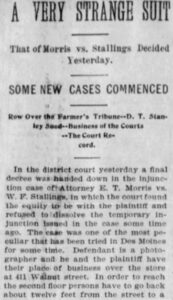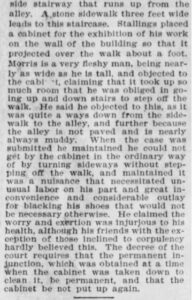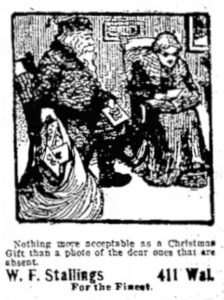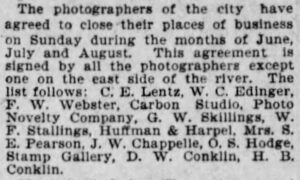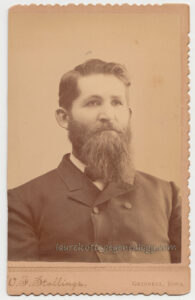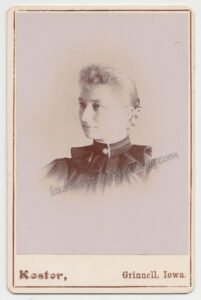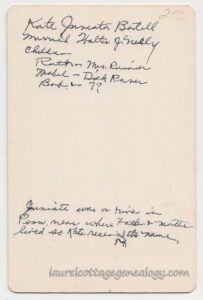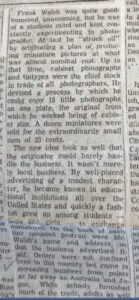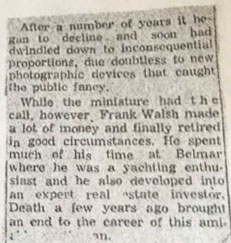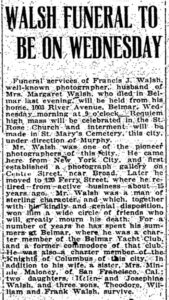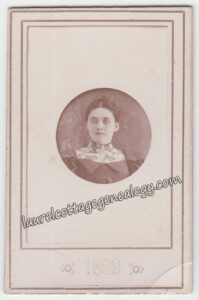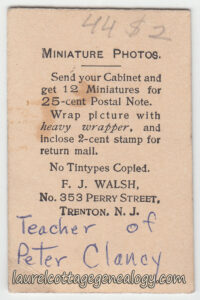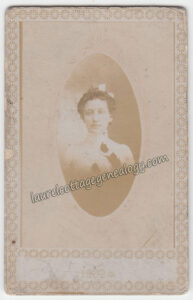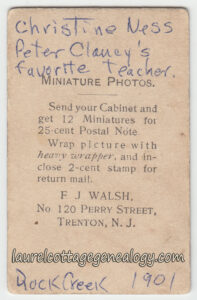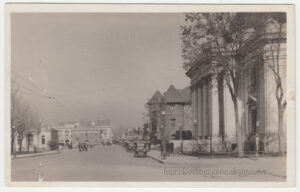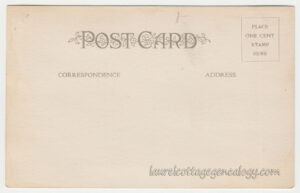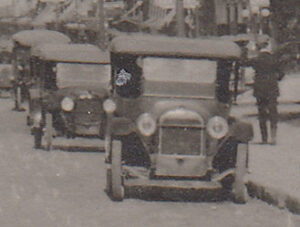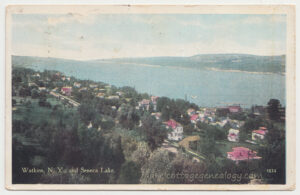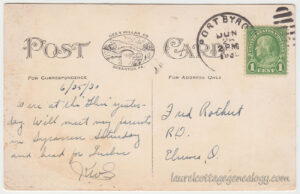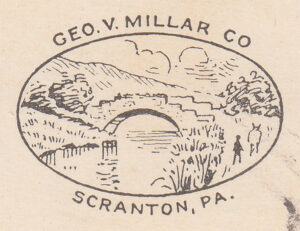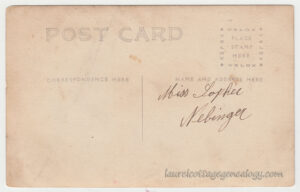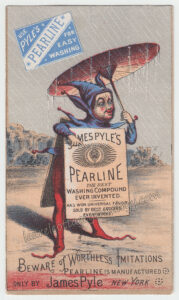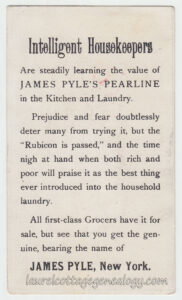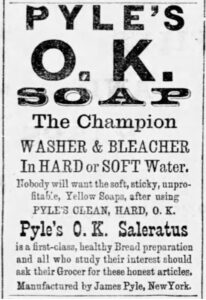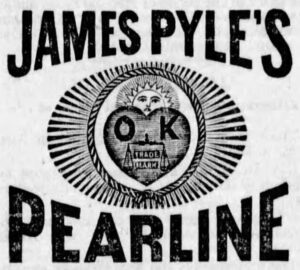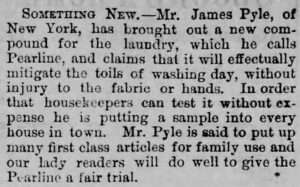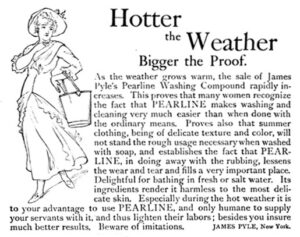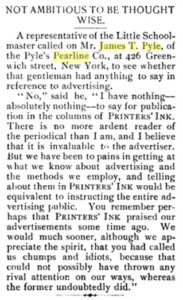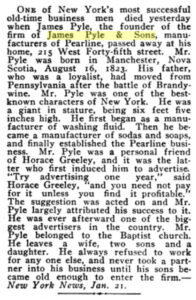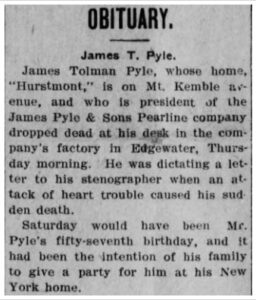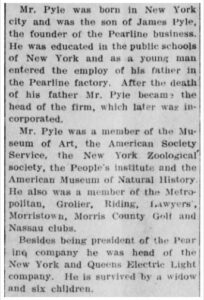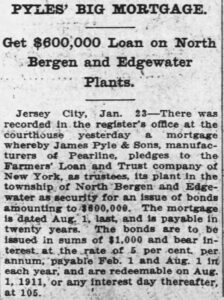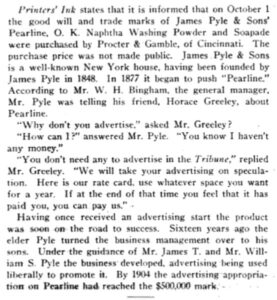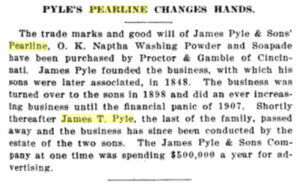Wesley F. Stallings, Jr. (1854 – 1940)
A few cabinet cards (ours included) show up online under W. F. Stallings. Digging a little, we find that he was Wesley F. Stallings. Our prior post shows he was working in Grinnell, Poweshiek County, Iowa, circa 1880s. By at least 1894 he had moved one county over, to the city of Des Moines, and there he plied his trade for about 36 years. For much of that time he was located on Walnut Street, before moving to Lynnville, Iowa around 1930.
Born January 4, 1854 in Jasper County, Iowa to Wesley F. Stallings, Sr. and Elizabeth Mayes, both natives of Tennessee; he married Emma N. White, about 1875. They had no children. Below, a rough timeline for his career:
1880 Federal Census, Lynn Grove Township, Jasper County, Iowa, with wife, Emma. Occupation listed as Artist – probably meaning “photo artist.”
1880s – 1893 – Working in Grinnell, Iowa. Thanks go to Dan Kaiser in his Grinnell Stories, who had located a cabinet card (no longer available) on Etsy by “Stalling,” address the corner of 4th and Main. This particular card had been stamped “J. M. Stonestreet, successor.” And another image there shows a photo by Stallings (spelled correctly this time) of 4th and Main – the Hatch Building. He must have had a 2nd or 3rd floor vantagepoint in a building across the intersection – it’s a great shot, wonderfully informative of old-time Grinnell, with its wooden sidewalks.
1889, a petition to Congress – photographers were not happy with the increased tax on photographic paper:
An illustrated monthly magazine, The Strand (1897/98) has a couple of the photographer’s photos for the June 17, 1892 tornado that tore through Grinnell, one of the worst in Iowa’s history. (See the horse that incredibly survived a “relocation.”)
1894 – 1896. Des Moines city directories – 411 Walnut St, residence same.
An ad from The Des Moines Register that ran in 1896:
Sued over space on walkway – from The Des Moines Register, February 1896:
1897 – 411 Walnut St, res 524 3rd
1899 – 411 Walnut St, res 1217 25th
A Christmas ad from December ’99 in The Daily Iowa Capital:
1900 Federal Census – 851 10th St, Des Moines. With wife Emma and niece, Carrie A. Taylor. Occupation photographer.
1901 – 411 Walnut St
Below, from The Des Moines Register, June 16, 1901 – photographers agree to follow the Sunday Blue Laws:
1902 – 411 Walnut St, residence w s e 17th, 1 s of Hubbell
1903 – 411 Walnut St, res Lincoln Ave, sw corner of Park (south Des Moines)
1907 – 615 W Walnut St
From the Des Moines Tribune, a December 1907 ad:
1908 – 615 Walnut St, 3rd flr, res Lincoln Ave, corner of Park Ave
1909 – 615 Walnut St, 3rd flr, res 1375 Pennsylvania Ave
1910 – 615 Walnut St, 2nd flr, res 1375 Pennsylvania Ave
1910 Federal Census, Des Moines, IA – Photographer, living on Walnut St, with wife Emma and niece, Carrie.
1911 – 615 Walnut St, 3rd flr
1912 – 305 7th, 2nd flr (possibly the Kraft Bldg), res 1824 High St
1913 – res 1824 High St
1916 – 412 Locust St, 2nd flr, (possibly the Kraft Bldg – 412-413 Kraft Bldg shows up as a general search for this address), res 1824 High St
1917 – Kraft Bldg, room 410 (7th and Walnut Streets)
1919 – 1922 – res 1824 High
1920 Federal Census – Des Moines. Residence 1824 High St., with wife Emma and lodger James White. Commercial photographer
1924 – 1927 – address 1554 E Walnut, most likely both business and residence
1930 Federal Census – Lynnville, IA. With wife, Emma. Photographer (own shop)
1931 – Spouse, Emma died September 6 in Lynnville, Iowa
1938 – About June 1938 moved to Newton, Iowa
1940 Federal Census – 702 First Avenue E., Newton, Jasper County, IA. Living at lodging house, widower. No occupation given.
No record with reference to a retirement date for W. F. Stallings was found but it would have been some time between the 1930 and 1940 census enumerations. Starting his trade around 1880 puts him at about 40-plus years in the business, definitely an uncommon feat, when many others’ careers were of relatively short duration (for varying reasons including competition and the growing popularity of personal cameras). And true to form with most of the other photographers we’ve researched that were long-lived in the business, the distinction of “commercial photographer” shows up in later decades – reflecting the necessity of adapting to change). Wesley died December 19, 1940 in Newton, Iowa.
________________________________________________________________________________
Sources: Year: 1880; Census Place: Lynn Grove, Jasper, Iowa; Roll: 346; Page: 261d; Enumeration District: 100. (Ancestry.com).
Congressional Record: Containing the Proceedings and Debates of the Fifty-first Congress, First Session. Also Special Session of the Senate. Vol. XXI. Washington: Government Printing Office, 1889. (google.books.com).
Kaiser, Dan. “Photography in Early Grinnell: A. L. Child’s Studio and Art Rooms.” Grinnell Stories, October 10, 2023. https://grinnellstories.blogspot.com/2023/10/photography-in-early-grinnell-l-childs.html.
Ancestry.com. U.S., City Directories, 1822-1995.
“A Very Strange Suit.” The Des Moines Register, February 26, 1896. Wednesday, p. 8. (Newspapers.com).
The Des Moines Register, August 30, 1896. Sunday, p. 13. (Newspapers.com).
The Strand, August 1897 – January 1898. Pg. 266. (books.google.com).
The Daily Iowa Capital, December 16, 1899. Saturday, p. 3. (Newspapers.com).
Year: 1900; Census Place: Des Moines, Polk, Iowa; Roll: 454; Page: 9; Enumeration District: 0077. (Ancestry.com).
The Des Moines Register, June 16, 1901. Sunday, p. 7. (Newspapers.com).
Des Moines Tribune, December 31, 1907. Tuesday, p. 7. (Newspapers.com).
Year: 1910; Census Place: Des Moines Ward 3, Polk, Iowa; Roll: T624_419; Page: 4b; Enumeration District: 0117; FHL microfilm: 1374432. (Ancestry.com).
The Des Moines Register, December 1, 1917. Saturday, p. 8. (Newspapers.com).
Year: 1920; Census Place: Des Moines Ward 1, Polk, Iowa; Roll: T625_507; Page: 9A; Enumeration District: 80. (Ancestry.com).
Year: 1930; Census Place: Lynn Grove, Jasper, Iowa; Page: 2A; Enumeration District: 0013; FHL microfilm: 2340395. (Ancestry.com).
State Historical Society of Iowa; Des Moines, IA, USA; Iowa Death Records, 1921-1940. (Ancestry.com).
Year: 1940; Census Place: Newton, Jasper, Iowa; Roll: m-t0627-01169; Page: 1A; Enumeration District: 50-25. (Ancestry.com).
State Historical Society of Iowa; Des Moines, IA, USA; Iowa Death Records, 1921-1940. (Ancestry.com).
“What are Sunday Blue Laws?” July 10, 2025. (gettips.com). Accessed July 29, 2025.



